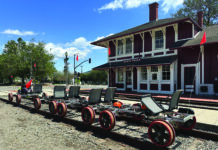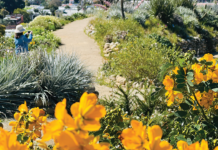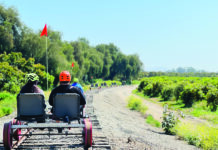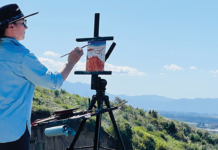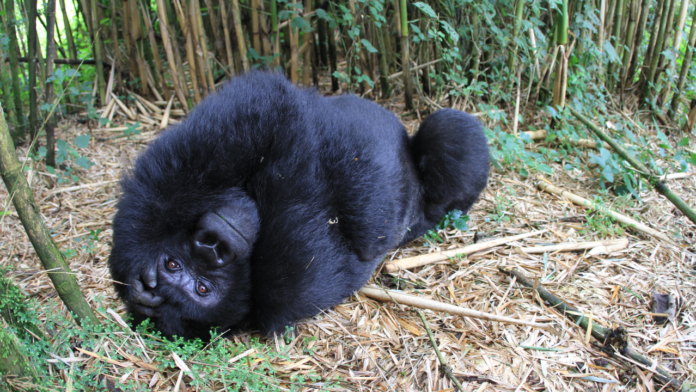Story and photos by Chuck Graham
The 500-pound silverback was hungry. Not hangry…just hungry.
As shafts of morning light penetrated the rainforest of the Virunga Mountains in Central Africa, the mountain gorilla casually lumbered over to a dense stock of bamboo, the biggest shafts as round as a baseball bat. He looked upward into the ceiling of the rainforest, presumably searching out what he deemed to be the best bamboo to sate his appetite.
When he found the stock he wanted, the burly silverback sat back on his haunches, grabbed the bamboo and proceeded to snap it off as easily as a toothpick with just one mighty hand. Yes, mountain gorillas are crazy strong, and at the same time quite gentle.
I was less than 20 feet away, resting quietly in the dense mountain flora. I was with two friends, Danny and Craig, and a handful of passionate park rangers. We were all blown away by the silverback’s otherworldly strength, his stoic behavior, and what little noise he made. His voracious appetite was also something to behold. Occasionally, there was a low murmuring grunt in between stripping thick strips of bamboo with an impressive set of teeth.
It is safe to say that all three of us were utterly amazed and in awe of being in the presence of one of the most endangered animals on the planet. It was February 2019. It was the second time I had been around mountain gorillas, but it had been a long while since my first encounter.
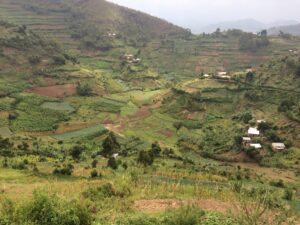
Laying Low in the Lowlands
My first trip into mountain gorilla habitat was in June 1991. I was in the lowlands of Kahuzi-Biéga National Park, located in what was then Eastern Zaire. Other than hanging out with a family of lowland mountain gorillas, it was without a doubt an extremely stressful excursion.
That region of Central Africa was volatile, to say the least, and has remained so throughout the years. In the summer of 1991, the country was in the throes of civil war. The Republic of Zaire became the Democratic Republic of the Congo in 1997, and the political unrest never seems to ease.
Nevertheless, amidst this political turmoil, I was fortunate to have the opportunity to see mountain gorillas. I fondly remember a baby gorilla being cradled by its doting mother as she consumed heaps of vegetation. I watched intently as they traded tender moments in the rainforest. Nearby was the dominant male. He had his back to me, but occasionally looked over his broad shoulders to give me a mere glance.
I was with a ranger who didn’t say much but knew exactly where to locate this troop of mountain gorillas. We were the only people with this troop, which was a special experience. At the same time it was troubling, considering the political strife surrounding the region. There always seemed to be an uneasy feeling hovering above the canopy.
At that moment, I wanted to hang onto that experience with that family of gorillas as long as I could. Unfortunately, the time spent with these extraordinary great apes was a blur. Rules being what they were, there was only about 90 minutes to enjoy being in their presence. It was time to head back to the border of Zaire and Burundi.
The mountain road there and back was terrifying. There were a couple of times where the outside wheels of the British army truck I was traveling in hung over the edge of a sheer cliff face, a river flowing several hundred feet below. The road was so rough, we had to patch a flat tire several times enroute to the border. Every time we stopped, locals appeared out of the brush watching every move we made. I could feel their desperation with their country on the brink.
We arrived at the border in the dark, and it was shut down for the night. Any sleep was a luxury. Everyone in the truck was running on fumes, and there was no rest because of political strife. Water, also an issue, had to be retrieved from a source where crocodiles lurked. All the while, I leaned on my 90 minutes with those lowland gorillas, majestic beauty thriving within a volatile land.
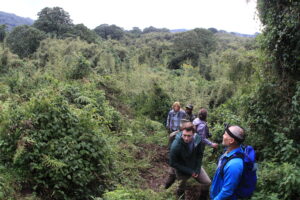
Mountain Innocence
Nearly 30 years later, in February 2019, Danny, Craig, and I drove from Uganda through Rwanda into DR Congo. As we approached Virunga National Park, the winding mountain roads revealed all the colorful patches of agricultural lands creeping up the steep mountainsides. Despite that, Virunga National Park is the African continent’s most biodiverse region, housing more than a thousand species of fauna.
The park itself resides in DR Congo, but the volcanic Virunga Mountain Range borders Uganda and Rwanda as well. I learned that, to increase biodiversity in the region, the Rwandan government was in the long process of buying land back in the Virunga Mountains, giving all flora and fauna a chance in the rainforest. There are only about 800 to 1,000 mountain gorillas left, so every plot of land bought back and returned to the rainforest is vital for populations of surviving mountain gorillas.
The next day, I killed time birding around the lodge. Beneath a canopy of dewy overcast, there were great opportunities around the lush gardens to see avian residents like mousebirds, boubous and robins. The most colorful, though, were the wide variety of sunbirds. They were virtual blurs flitting among vibrant hibiscus and roses.
We were up early the following morning, anticipating what we might see. After meeting with our guide and accompanying team of rangers, we drove into the lowlands before hiking into the rainforest. There was a lot of radio chatter amongst them as we kept in a tight single file.
Many rangers working as mountain guides are former poachers. Instead of letting another endangered species waste away, they flipped the script, realizing that saving such a valuable resource and natural wonder was crucial for the species and their country.
Maybe 30 minutes into our hike in the dense mountain flora, we were told to remain silent and that there was to be no movement. A family of gorillas was close by. All of us heard some thrashing in the dense thickets. It was a baby mountain gorilla. It was only a couple months old, but it possessed all the lively exuberance of a 2-year-old child.
With morning dew drops clinging to its jet-black fur, this precocious baby mountain gorilla was having a ball. It repeatedly clambered up the back of its mother, demanding her attention. Then a series of impressive somersaults followed in the wet grass, an open patch for us to observe its playful behavior. Mom and baby were just 10 feet away as the rangers stayed right behind us.
Then the baby closed to within two feet of us. It looked at us, and seemed to know how cute…or possibly how mischievous…it was. It rolled and bounced around us, making several passes before heading back to mom. The youngster climbed up its mother’s back, where she sauntered off before us, while melding back into the rainforest.
We were speechless. Amazed and humbled by a vision of carefree joy and innocence in a creature seemingly removed from the strife that surrounded it.
Kahuzi-Biéga National Park
www.kahuzi-biega.com
Virunga National Park
virunga.org














